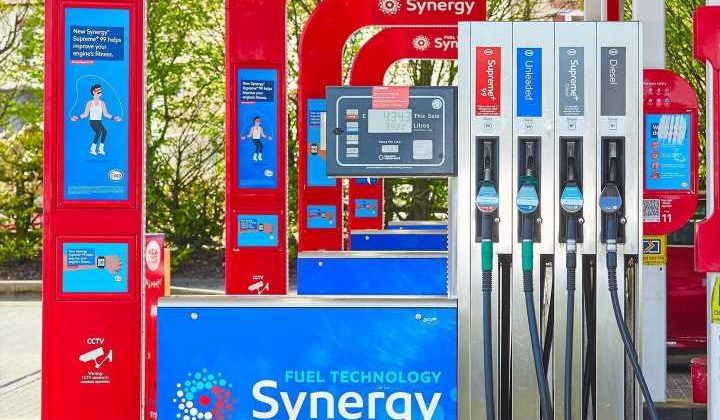We talk petrol with Esso to find out how additives work – and why some fuels still don't have ethanol | PROMOTED
By Sponsored / Wednesday, December 8, 2021 / Loading comments
There are no shortage of questions when given the chance to chat with two of Esso’s senior fuel development engineers. But the fact both Zsolt Lengyel and Connor LaPres are based on the other side of the Atlantic, working in ExxonMobil’s huge Research and Engineering Center in New Jersey, makes the first one inevitable. Why are European and American octane numbers different?
“The numbers themselves mean the same things – measuring an engine’s resistance to knock,” Lengyel says, “which is when the air-fuel mixture is set off by something other than the spark plug. There are two different ways to measure octane, Motor Octane Number and Research Octane Number. The tests are similar, and utilise specialised engines with adjustable compression ratios, but were designed to represent different driving conditions. In the U.S. they average the two together, in Europe and the UK they just use the Research Octane Number.”
Hence ‘RON’, and why our numbers are bigger – American 93 is similar to a European 98 or 99. Which leads to the chance to discuss the obvious distinction of Esso’s Synergy Supreme+ 99, the joint highest octane pump fuel you can buy in Britain – what practical advantages does higher octane bring?
“Put simply the higher the octane number, the more resistant to knock it is,” Lengyel says, “which enables things like higher compression ratios and running the engine harder.”
So more performance, in other words. And while modern engines will adjust their timing to take account of lower octane fuel, using microphones in their blocks to detect the onset of knock, performance engines need the good stuff to give their best. And it turns out that more humble powerplants will often benefit from it, too.
“We’ve done lots of testing with cars designed for regular fuel and put higher octane in them,” Lengyel says, “some of them respond and some of them don’t, it depends on how the manufacturer has calibrated them. But there are some surprisingly humble cars that show real benefits.”
Discussions about fuel tend to head in certain directions. With one of the common end points the assertion that, beyond octane numbers, all are basically the same.
At one level it turns out that’s true. Both Lengyel and LaPres confirm that the basic chemistry of all similar grade petrol is very close, with much of it legally defined by standards in different countries. But the small differences are the critical ones, which is where the work of fuel engineers comes in.
“Our additives packages are designed to do a number of things, but principally to clean fuel injectors and intake valves,” Lengyel explains, when asked what distinguishes Esso’s Synergy Supreme+ 99 from regular fuels. “It contains a detergent which helps clean up deposits and also a friction reducing component which goes through the fuel then migrates into the sump and helps reduce friction on critical parts.”
Huge research goes into creating and testing these formulations, as well as making certain buyers get the same product wherever they fill up. Esso actually introduces tiny quantities of ‘marker molecules’ with a unique signature so the fuel can be traced through the distribution process, and to make sure it keeps the right concentration. That also makes it much more consistent than aftermarket fuel additives. “Think of it as continuous maintenance as opposed to shock treatment,” says Lengyel, “fuel that’s been designed to be used safely all the time.”
Petrol is also subtly tweaked to take account of differing climates, and even seasons in some markets with a big change in temperatures. “There are different specifications for key properties throughout the year,” LaPres says, “so things like vapour pressure will change.” This being the measurement of how much fuel evaporates at ambient temperature – the aim being for not too much in summer, but with the requirement for enough volatility to get the fuel easily vaporised during a winter cold start.
The other change is increasing ethanol content, with Britain having recently switched 95-RON petrol to a 10 percent ethanol standard known as E10. The change has meant that older cars – many of which can’t run on E10 as it can attack their fuel systems’ seals and gaskets – will now be relying on higher octane fuels. Most higher octane fuels from other brands in the UK have kept to the older five percent E5 standard, but Esso’s Synergy Supreme+ 99 is still ethanol free in much of the country, since all the Supreme+ 99 that comes from Esso’s Fawley Refinery remains ethanol-free. (The area pretty much corresponds to distribution south of Birmingham and east of Exeter.)
Nor is it just older and more exotic cars that benefit from ethanol-free super unleaded Esso Synergy Supreme+ 99, with Lengyel admitting the lack of ethanol can be an advantage for much more humble machinery, like older petrol lawnmowers. “For two-strokes ethanol doesn’t lubricate quite as well, so it probably is a good idea to put the 99 in there.”
It might get the garden trimmed a bit quicker, too. The final question is another obvious one: what do fuel engineers drive themselves. “I’ve got a compact SUV, nothing special,” says LaPres, admitting her enthusiasm for performance machinery has only started to develop since she began her role. But Lengyel’s choice is reassuringly traditional: “I drive a 2010 Mustang. And yes, it does have the V8.”
This is a promotional feature written by PistonHeads for Esso. For the chance to win an F1 Simulator session and a tour of Red Bull Racing, please click here.
Latest Promotions articles
Why octane matters | PH Explains
Compare car insurance quotes from 100+ providers
How will insurance work with autonomous cars?
A complete guide to electric car charging at home
Rocketing secondhand car prices spell good news…
Source: Read Full Article
